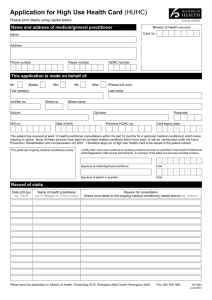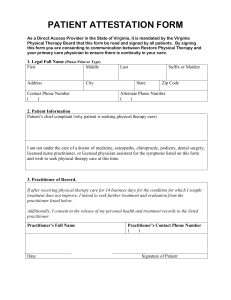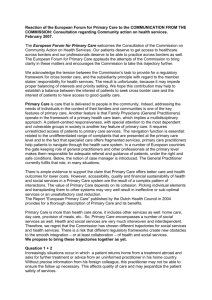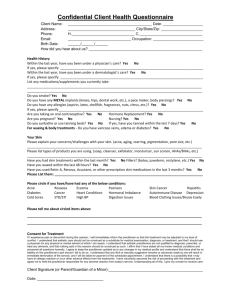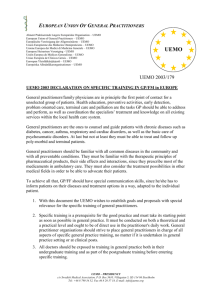Measures of Implementation Components
advertisement
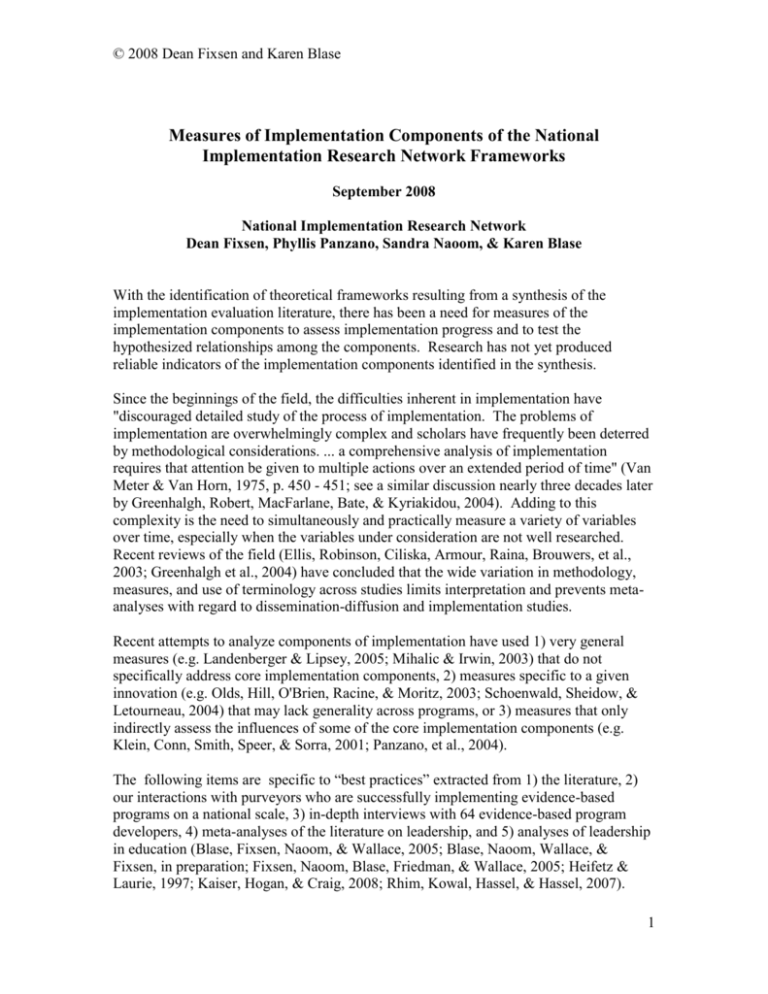
© 2008 Dean Fixsen and Karen Blase Measures of Implementation Components of the National Implementation Research Network Frameworks September 2008 National Implementation Research Network Dean Fixsen, Phyllis Panzano, Sandra Naoom, & Karen Blase With the identification of theoretical frameworks resulting from a synthesis of the implementation evaluation literature, there has been a need for measures of the implementation components to assess implementation progress and to test the hypothesized relationships among the components. Research has not yet produced reliable indicators of the implementation components identified in the synthesis. Since the beginnings of the field, the difficulties inherent in implementation have "discouraged detailed study of the process of implementation. The problems of implementation are overwhelmingly complex and scholars have frequently been deterred by methodological considerations. ... a comprehensive analysis of implementation requires that attention be given to multiple actions over an extended period of time" (Van Meter & Van Horn, 1975, p. 450 - 451; see a similar discussion nearly three decades later by Greenhalgh, Robert, MacFarlane, Bate, & Kyriakidou, 2004). Adding to this complexity is the need to simultaneously and practically measure a variety of variables over time, especially when the variables under consideration are not well researched. Recent reviews of the field (Ellis, Robinson, Ciliska, Armour, Raina, Brouwers, et al., 2003; Greenhalgh et al., 2004) have concluded that the wide variation in methodology, measures, and use of terminology across studies limits interpretation and prevents metaanalyses with regard to dissemination-diffusion and implementation studies. Recent attempts to analyze components of implementation have used 1) very general measures (e.g. Landenberger & Lipsey, 2005; Mihalic & Irwin, 2003) that do not specifically address core implementation components, 2) measures specific to a given innovation (e.g. Olds, Hill, O'Brien, Racine, & Moritz, 2003; Schoenwald, Sheidow, & Letourneau, 2004) that may lack generality across programs, or 3) measures that only indirectly assess the influences of some of the core implementation components (e.g. Klein, Conn, Smith, Speer, & Sorra, 2001; Panzano, et al., 2004). The following items are specific to “best practices” extracted from 1) the literature, 2) our interactions with purveyors who are successfully implementing evidence-based programs on a national scale, 3) in-depth interviews with 64 evidence-based program developers, 4) meta-analyses of the literature on leadership, and 5) analyses of leadership in education (Blase, Fixsen, Naoom, & Wallace, 2005; Blase, Naoom, Wallace, & Fixsen, in preparation; Fixsen, Naoom, Blase, Friedman, & Wallace, 2005; Heifetz & Laurie, 1997; Kaiser, Hogan, & Craig, 2008; Rhim, Kowal, Hassel, & Hassel, 2007). 1 © 2008 Dean Fixsen and Karen Blase The “implementation climate” items are adapted from the work of Klein & Sorra (1996) and Panzano and colleagues (2004; 2006). The reliability and validity of those items have been established. The reliability and validity of the remaining items have not been tested. For more information on the National Implementation Research Network frameworks for Implementation Drivers and Implementation Stages, go to http://nirn.fpg.unc.edu. You have our permission to use these measures in any non-commercial way to advance the science and practice of implementation, organization change, and system transformation. Please let us know how you are using the measures and let us know what you find so we can all learn together. As you use these measures, we encourage you to do cognitive interviewing of key informants to help us revise the wording of the items to help ensure each item taps the desired aspect of each implementation component. With our pooled data, statistical analyses will help to establish the psychometric qualities of the items and the overall survey. We ask that you let us know how you use these items so we can use your experience and data to improve and expand the survey. Please respond to Dean Fixsen (contact information below). Thank you. Dean L. Fixsen, Ph.D. Senior Scientist FPG Child Development Institute CB 8040 UNC-Chapel Hill 105 Smith Level Road Chapel Hill, NC 27599-8040 fixsen@mail.fpg.unc.edu Cell # 727-409-1931 Reception 919-962-2001 Fax 919-966-7463 References Blase, K. A., Fixsen, D. L., Naoom, S. F., & Wallace, F. (2005). Operationalizing implementation: Strategies and methods. Tampa, FL: University of South Florida, Louis de la Parte Florida Mental Health Institute. http://nirn.fmhi.usf.edu/resources/detail.cfm?resourceID=48 Ellis, P., Robinson, P., Ciliska, D., Armour, T., Raina, P., Brouwers, M., et al. (2003). Diffusion and Dissemination of Evidence-Based Cancer Control Interventions. (No. Evidence Report /Technology Asessment Number 79. (Prepared by Oregon Health and Science University under Contract No. 290-97-0017.) AHRQ Publication No. 03-E033. Rockville, MD: Agency for Healthcare Research and Quality. Fixsen, D. L., Naoom, S. F., Blase, K. A., Friedman, R. M., & Wallace, F. (2005). Implementation Research: A synthesis of the literature. Tampa, FL: University of South Florida, Louis de la Parte Florida Mental Health Institute, The National Implementation Research Network (FMHI Publication #231). http://nirn.fmhi.usf.edu/resources/detail.cfm?resourceID=31 2 © 2008 Dean Fixsen and Karen Blase Greenhalgh, T., Robert, G., MacFarlane, F., Bate, P., & Kyriakidou, O. (2004). Diffusion of innovations in service organizations: Systematic review and recommendations. The Milbank Quarterly, 82(4), 581-629. Heifetz, R. A., & Laurie, D. L. (1997). The work of leadership. Harvard Business Review, 75(1), 124-134. Kaiser, R. B., Hogan, R., & Craig, S. B. (2008). Leadership and the fate of organizations. American Psychologist, 63(2), 96-110. Klein, K. J., & Sorra, J. S. (1996). The challenge of innovation implementation. Academy of Management Review, 21(4), 1055-1080. Klein, K. J., Conn, B., Smith, A., Speer, D. B., & Sorra, J. (2001). Implementing computerized technology: An organizational analysis. Journal of Applied Psychology, 86(5), 811-824. Landenberger, N. A., & Lipsey, M. W. (2005). The Positive Effects of Cognitive-Behavioral Programs for Offenders: A Meta-Analysis of Factors Associated with Effective Treatment. Journal of Experimental Criminology, 1(4), 451-476. Mihalic, S., & Irwin, K. (2003). Blueprints for Violence Prevention: From Research to RealWorld Settings-Factors Influencing the Successful Replication of Model Programs. Youth Violence and Juvenile Justice, 1(4), 307-329. Olds, D. L., Hill, P. L., O'Brien, R., Racine, D., & Moritz, P. (2003). Taking preventive intervention to scale: The nurse-family partnership. Cognitive and Behavioral Practice, 10, 278-290. Panzano, P. C., & Roth, D. (2006). The decision to adopt evidence-based and other innovative mental health practices: Risky business? Psychiatric Services, 57(8), 1153-1161. Panzano, P. C., Seffrin, B., Chaney-Jones, S., Roth, D., Crane-Ross, D., Massatti, R., et al. (2004). The innovation diffusion and adoption research project (IDARP). In D. Roth & W. Lutz (Eds.), New research in mental health (Vol. 16). Columbus, OH: The Ohio Department of Mental Health Office of Program Evaluation and Research. Rhim, L. M., Kowal, J. M., Hassel, B. C., & Hassel, E. A. (2007). School turnarounds: A review of the cross-sector evidence on dramatic organizational improvement. Lincoln, IL: Public Impact, Academic Development Institute. Schoenwald, S. K., Sheidow, A. J., & Letourneau, E. J. (2004). Toward Effective Quality Assurance in Evidence-Based Practice: Links Between Expert Consultation, Therapist Fidelity, and Child Outcomes. Journal of Clinical Child and Adolescent Psychology, 33(1), 94-104. Van Meter, D. S., & Van Horn, C. E. (1975). The policy implementation process: A conceptual framework. Administration & Society, 6, 445-488. 3 © 2008 Dean Fixsen and Karen Blase Implementation Drivers Key informants The following set of items is intended to be used with three groups of key informants within a human service organization. The information from all key informants should be obtained within a four-week period to help assure a complete view of implementation progress at one point in time within the organization. The measures can be repeated to assess initial progress toward full implementation and to assess changes in implementation over time (implementation supports fluctuate over time). The key informants are: 1. Practitioners who are providing services to children, families, or adults. Depending upon the number of practitioners using an innovation in an organization, it may be useful to randomly sample 10 to 15 practitioners at each point in time. 2. Supervisors/ Coaches who provide oversight and advice to the practitioners who are asked to complete this survey. 3. Decision makers who are responsible for the overall organization or the portion of the organization in which the practitioners and supervisors/ coaches work. Decision makers are those people who have nearly-independent authority to make changes in budgets, structures, and personnel roles and functions within an organization. The wording of items may need to be changed to reflect the usage of language or identification of particular roles within a given organization. Name of the innovation:______________________________________ NOTE: Responses should be specific to one particular innovation. If the organization is implementing more than one innovation, a separate survey is required for each. DEFINITIONS 1. Innovation a. The practice or program that is the subject of this survey. Innovations require new ways of working with consumers or other recipients of services provided by a practitioner. NOTE: The practice or program may or may not have a strong evidence-base to support it. The implementation questions below are relevant to any attempt to establish any new ways of work in any organization. 2. Practitioner a. The clinician or other person who is providing direct services to consumers or others. A practitioner is a person who is being asked to use an innovation. 4 © 2008 Dean Fixsen and Karen Blase Enter 1 - 9 next to each item to indicate the extent to which you agree the statement is true for your organization. 1 = Strongly Disagree 2 = Disagree 3 = Somewhat Disagree 4 = Neither Agree nor Disagree 5 = Somewhat Agree 6 = Agree 7 = Strongly Agree 8 = Does Not Exist in our organization 9 = Don’t Know Practitioner Selection When an innovation is introduced to an organization (or sustained over time as staff expansion or turnover occurs), practitioners must be employed to interact with consumers using the new ways of work. The items in this section ask about the activities related to recruiting, interviewing, or hiring new practitioners or existing practitioners within the organization. Within the past six months: NOTE: A shorter time frame may be used to assess implementation progress more often during each year. For example, surveying key informants every four months will provide three data points a year. 1. Practitioners already employed by the provider organization are appointed to carry out this innovation. For example, without much discussion existing staff have been reassigned to use the innovation. 2. Practitioners already employed by the provider organization voluntarily applied to carry out this innovation. For example, there was a process where currently employed practitioners could learn about the innovation and decide if they wanted to make use of it in their work with consumers. 3. New staff members have been specially hired to be the practitioners using the innovation. That is, a new position was created and a new person was recruited and employed to be a practitioner. 4. Interviews to determine whether or not to employ a person to be a practitioner for this innovation have been conducted in-house by the provider organization's own staff. Note that this question applies to interviews of practitioners who voluntarily applied from within the organization as well as to those candidates who applied to be new employees of the organization. 5. Interviews to determine whether or not to employ a person to be a practitioner for this innovation have been conducted by one or more persons who are expert in the innovation. For example, the interviewers are part of the research group that developed the innovation or are specially trained to do interviews for this innovation. 5 © 2008 Dean Fixsen and Karen Blase 6. Earlier in their career, nearly every person involved in interviewing candidates had been a practitioner using the innovation. 7. Interviews to determine whether or not to employ a person to be a practitioner for this innovation primarily have been focused on questions specifically related to the innovation. 8. Interviews to determine whether or not to employ a person to be a practitioner for this innovation have included role plays to elicit responses from candidates. For example, a role play situation might ask the candidate to respond to a situation that is acted out by the persons doing the interview. The situation might be typical of the kinds of issues a practitioner faces every day when using the innovation. 9. Data regarding practitioner performance in employment interviews have been collected and reported to management or a data collection unit. Training Innovations involve new ways of doing work with consumers and often require practitioners to acquire new knowledge, skills, and abilities. These items ask about any activities related to providing specialized information, instruction, or skill development in an organized way to practitioners and other key staff in an organization. Within the past six months: 1. Practitioners have been provided with specific preparation to carry out this innovation. 2. Training for practitioners primarily has been provided in-house by the provider organization's own staff. 3. Practitioner training primarily has been provided off site (e.g. a national or regional training center; conference). 4. Practitioner training has been provided by one or more persons who are expert in the innovation. For example, the trainers are part of the research group that developed the innovation or are specially trained to do training for this innovation. 5. Training for practitioners primarily has been focused on content specifically related to the innovation. 6. Earlier in their career, nearly every trainer had been a practitioner using the innovation. 7. Training for practitioners has included behavior rehearsals to develop knowledge and skills to an established criterion. Behavior rehearsals are set up to allow the practitioner to practice saying and doing aspects of the innovation they are expected to use after training has ended. 8. Behavior rehearsals during training have included re-practice until a criterion for skill acquisition has been reached (e.g. 80% of the components done properly). 9. Data regarding practitioner knowledge and performance relative to the innovation has been assessed before and after training and reported to management or a data collection unit. 6 © 2008 Dean Fixsen and Karen Blase Supervision/ Coaching Practitioners often are supported by supervisors or coaches as they work with consumers. These items ask about supervision/ coaching that may include personal observation, instruction, feedback, emotional supports, some form of training on the job, or debriefing sessions. 1. Each practitioner using this innovation has an assigned supervisor/ coach. 2. Supervision/ coaching for practitioners primarily is provided in-house by the provider organization's own staff. 3. The supervisor/ coach for every practitioner is expert in the innovation. For example, the coaches are part of the research group that developed the innovation or are specially trained to coach practitioners using this innovation. 4. Earlier in their career, every supervisor/ coach had been a practitioner using the innovation. 5. Supervision/ coaching primarily has been focused on helping practitioners develop their knowledge and skills specific to the innovation being implemented. 6. Supervisors/ coaches have been careful to match the content of supervision with the content of training. 7. Supervision/ coaching has occured on a regular schedule known to the practitioner. 8. Supervision/ coaching has occured a minimum of once a week for each practitioner who has been using the innovation for less than 6 months. 9. Supervision/ coaching for practitioners has included a considerable amount of direct observation of clinical skills on the job. 10. Information and/or data regarding the results of practitioner supervision/ coaching contacts have been routinely collected and reported to management or a data collection unit. Performance Assessment Many organizations have some way to assess the quality and quantity of work done by practitioners and others involved in providing services to consumers. The information may be used for certification, merit pay increases, promotions, or decisions about continued employment. These items ask about the nature and content of performance assessments relative to practitioners’ use of the innovation in the organization. Within the past six months: 1. The performance of each practitioner using this innovation has been evaluated with respect to adherence. That is, the critical features of the innovation are listed/ defined and a method is used to determine the practitioner’s use of each critical feature. 2. The performance of each practitioner using this innovation has been evaluated with respect to outcomes achieved. That is, the progress of each consumer being served by a practitioner is measured. 3. Practitioner performance assessments has included direct observations and ratings of knowledge, skills, and abilities. 7 © 2008 Dean Fixsen and Karen Blase 4. Practitioner performance assessments have included opinions and ratings of performance by consumers and stakeholders. 5. Nearly all of the practitioner performance assessment questions/ observations have been specific to the innovation. 6. Practitioners have been well informed in advance regarding the purpose, content, and methods used to carry out practitioner performance assessments. 7. Assessments of practitioners' performance have been conducted in-house by the provider organization's own staff. 8. Assessments of practitioners’ performance have been conducted by individuals who are specifically trained to evaluate the performance of practitioners using the innovation. 9. Practitioners have received written results within 30 days of the performance assessment. 10. Data regarding the results of practitioner performance assessments have been routinely collected and reported to management or a data collection unit. Decision Support Data Systems Many organizations have some way to assess the overall performance of various units and of the overall organization itself. The information may be used for internal or external accountability purposes, quality improvement, or decisions about contracts and services. These items ask about the nature and content of assessments relative to decision making regarding the use of the innovation in the organization. Within the past six months: 1. The provider organization has had a data collection and reporting system in place. 2. Assessments of organizational performance primarily have been conducted inhouse by the provider organization's own staff. 3. There have been specific protocols used for data collection and analysis (e.g. specific measures, data collection routines, schedules for data collection) 4. There have been specific protocols used for data reporting (e.g. schedules, formats for data reporting, schedule of meetings for discussion and interpretation of results) 5. Organizational data collection measures primarily have been designed to acquire information specific to the processes of the innovation. 6. Organizational data collection measures primarily have been designed to acquire information specific to the outcomes of the innovation. 7. Information from data collection systems has been provided to practitioners at least monthly. 8. Information from data collection systems has been provided to supervisors/ coaches at least monthly. 9. Information from data collection systems has been provided to managers and directors at least quarterly. 8 © 2008 Dean Fixsen and Karen Blase Facilitative Administration Many organizations establish structures and processes to support and actively pursue agendas to encourage and support the use of an innovation by practitioners. These items ask about any changes in the organization related to the use of the innovation. Within the past six months: 1. Administrative practices and procedures have been altered to accommodate the specific, identified needs of the innovation (e.g. personnel reporting arrangements; accountability methods; financing methods). 2. Administrative policies have been altered to accommodate the specific, identified needs of the innovation (e.g. revised policy and procedure manuals; modified merit pay criteria). 3. Administrative staff (key directors, managers, and supervisors) have received explicit training regarding their functions related to the innovation. 4. Adjustments have been made in organizational structures and roles specifically to promote effective use of the innovation (e.g. alignment of internal organizational systems to facilitate and support the work of practitioners, interviewers, trainers, coaches, and performance assessors). 5. New administrative practices and procedures have been put in place to facilitate the practice (e.g., new job descriptions and salary structures; new meeting schedules, new Board committees; written implementation plan). 6. Administrative staff has routinely used data when making decisions about changes in the organization. 7. Administrative staff has routinely used data when making decisions about staff performance. Systems Intervention Organizations may work with the larger systems in the region and state to develop better supports for the use of an innovation. These items ask about changes in external system policies, management, or operating structures or methods in response to experiences gained with the operations of an innovation. Within the past six months: 1. Administrative staff of the provider organization (key directors, managers, and supervisors) have actively worked to change external systems so they are more hospitable to the specific methods, philosophy, and values of the innovation. 2. Administrative staff of the provider organization (key directors, managers, and supervisors) have received explicit training with respect to specific approaches for intervening in external systems. 3. Administrative staff of the provider organization (key directors, managers, and supervisors) have secured adequate resources to initiate and use the innovation effectively (e.g. assure appropriate referrals, sufficient funding, staff certification, agency accreditation, consumer and stakeholder support, community support). 4. Administrative staff of the provider organization (key directors, managers, and supervisors) have secured adequate resources to sustain the innovation effectively 9 © 2008 Dean Fixsen and Karen Blase (e.g. assure appropriate referrals, sufficient funding, staff certification, agency accreditation, consumer and stakeholder support, community support). Leadership Organizations have leaders at various levels who make decisions that impact the way practitioners work with consumers. These items ask about the nature of leadership within the organization. Within the past six months: 1. Leaders within the organization continually have looked for ways to align practices with the overall mission, values, and philosophy of the organization. 2. Leaders within the organization have established clear and frequent communication channels to provide information to practitioners and to hear about their successes and concerns. 3. Leaders within the organization have convened groups and worked to build consensus when faced with issues on which there was little agreement about how to proceed. 4. Leaders within the organization have provided specific guidance on technical issues where there was sufficient clarity about what needed to be done. 5. Leaders within the organization have been fair, respectful, considerate, and inclusive in their dealings with others. 6. Leaders within the organization have been very good at focusing on the issues that really matter at the practice level. 7. Leaders within the organization have been very good at giving reasons for changes in policies, procedures, or staffing. 8. Leaders within the organization have been actively engaged in resolving any and all issues that got in the way of using the innovation effectively. 9. Leaders within the organization have actively and routinely sought feedback from practitioners and others regarding supports for effective use of the innovation. 10. Leaders within the organization have been actively involved in such things as conducting employment interviews, participating in practitioner training, conducting performance assessments of individual practitioners, and creating more and better organization-level assessments to inform decision making. Implementation Climate Organizations have a “personality” that is reflected in the day to day operations of the organization and the way staff members view their work. These items ask about some dimensions that relate to the use of innovations in organizations. Within the past six months: 1. The innovation is compatible with the treatment philosophy of the organization as a whole. 2. The innovation is being implemented in this organization as prescribed by the experts. 10 © 2008 Dean Fixsen and Karen Blase 3. Staff who are expected to use the innovation are doing so willingly in carrying out their job duties. 4. The innovation is being used “to the letter” as prescribed by its developers. 5. Local system issues interfered with the implementation of the innovation at this organization. 6. The “benefits” that have resulted from implementing the innovation far exceed the “costs”. 7. Staff are adequately trained to use the innovation in this organization. 8. Positive consequences occurred at this organization as a result of implementing the innovation. 9. The innovation is available to all community members who indicated a need or an interest. 10. The innovation is used in a committed way by targeted staff at this organization. 11. This organization’s overall effectiveness has improved as a result of implementing the innovation. 12. Client outcomes have improved as a result of using the innovation. 13. There was adequate time to plan the details of implementing the innovation at this organization. 14. Top administration strongly supports the ongoing implementation of the innovation. 15. Staff get positive feedback and/or recognition for their efforts to use the innovation. 16. Top administrators minimized obstacles and barriers to using the innovation at this organization. 17. Funding issues interfered with the use of the innovation at this organization. 18. Implementing the innovation involved taking a big risk at this organization. 19. This organization set clear and specific goals related to the use of the innovation. 20. The use of the innovation has been consistent over time at this organization. 21. There are performance-monitoring systems in place to guide the implementation of the innovation. 22. Training and technical assistance were readily available to staff involved in using the innovation. 23. Adequate resources have been available to use the innovation as prescribed. 24. The “costs” of using the innovation have far exceeded any benefits that may have occurred. 25. Staff have been encouraged to express concerns that arise in the course of using the innovation. 26. The innovation is being seen as a regular part of the programming offered to this community. 27. Efforts are in the works to see that this innovation becomes a permanent part of our service offerings 28. It is difficult to attract and/or retain qualified staff needed to use the innovation. 29. Based on data available, this program has been effective in reducing the targeted negative behavior of consumers. 30. Many things needed to change at this organization in order to use the innovation as prescribed. 11 © 2008 Dean Fixsen and Karen Blase 31. The effectiveness of the innovation is apparent to stakeholders outside this organization. 32. The innovation is compatible with the professional training of targeted staff at this organization. 12 © 2008 Dean Fixsen and Karen Blase Stages of Implementation The indicators drafted for the Stages of Implementation are the authors’ best estimations of distinct “phase changes” based on a few decades of experience and reviews of the implementation literature and successful practices. In principle, the Stages are fairly straightforward. In practice, they are not linear so you will face measurement challenges not described here. Note that the Stages are fluid with agencies going into and out of a Stage over and over. Even skilled purveyor groups find that it takes about 3 or 4 years to get an agency to the point of Full Implementation (as defined here) and even with a lot of help not all agencies that attempt implementation of an EBP ever reach that point. Note that the proposed criteria for Stages apply to a single, specified EBP or innovation. A single agency might be in the Full Implementation Stage with one innovation and in the Exploration Stage with another. It may require interviews with several key informants to find the information you need to determine where an organization is with regard to its Stage of Implementation. Exploration: An agency/ group is 1) ACTIVELY CONSIDERING the use of an EBP or other innovation but has not yet decided to actually begin using one. The group may be assessing needs, getting buy in, finding champions, contacting potential purveyors, or any number of things -- but 2) THEY HAVE NOT DECIDED to proceed. Once the decision is reached to use a particular innovation, the Exploration Stage ends (of course, in reality, it is not always such a neat and tidy conclusion). Installation: An agency group 1) HAS DECIDED to use an innovation and 2) IS ACTIVELY WORKING to get things set up to use it. The group may be writing new recruiting ads and job descriptions, setting up new pay scales, re-organizing a unit to do the new work, contracting with a purveyor, working on referral sources, working on funding sources, purchasing equipment, finding space, hiring trainers and coaches, or any of a number of things -- but 3) THE FIRST PRACTITIONER HAS NOT begun working with the first client/consumer using the new EBP/ innovation. It seems that many agencies get into this Stage and find they do not have the resources/ desire to continue. These agencies might go back to the Exploration Stage (provided the 2 criteria for that Stage are being met) or may abandon the process altogether. 13 © 2008 Dean Fixsen and Karen Blase Initial Implementation: The timer on this Stage BEGINS the day 1) the first NEWLY TRAINED PRACTITIONER 2) attempts to USE THE NEW EBP/ INNOVATION WITH A REAL CLIENT/ CONSUMER. There may be only one practitioner and only one client/ consumer, but that is enough to say the Initial Implementation Stage has begun and is in process. If at a later time an agency has no trained practitioner working with a client/consumer, the agency might be said to be back in the Installation Stage (provided the 3 criteria for that Stage are being met at that time). It seems that many agencies get into this Stage and limp along for a while without establishing/ building in/ improving their capacity to do the implementation work associated with the evidence-based program (e.g. full use of the Implementation Drivers including practitioner selection, training, coaching, and performance/ fidelity assessments; facilitative administration, decision support data systems, and systems interventions). Consequently, most of these efforts are not very successful re: consumer outcomes and rarely are sustained (they come and go with champions and interested staff). Full Implementation: Determine the number of POSITIONS the agency has allocated as practitioners for the innovation. Determine the number of practitioners that CURRENTLY meet all of the fidelity criteria. FULL IMPLEMENTATION OCCURS WHEN AT LEAST 50% OF THE POSITIONS ARE FILLED WITH PRACTITIONERS WHO CURRENTLY MEET THE FIDELITY CRITERIA. If there is no fidelity assessment in place, Full Implementation cannot be reached. If there are 10 positions and 6 vacancies, Full Implementation cannot be reached. Note that Full Implementation lasts only as long as the 50% criterion is met -- this may be only for one day initially since meeting fidelity once is no guarantee that it will ever occur again for that practitioner. In addition, practitioners come and go and when a high fidelity practitioner is replaced with a newly hired/ trained practitioner it takes a while and a lot of coaching to generate high fidelity performance with the new person. When there is a very demanding innovation and fairly high practitioner turnover, an agency may take a long time to reach Full Implementation. Innovation: We debated about including this as a "stage" but we wanted to make the point that high fidelity comes first then adaptations are allowed. Diffusion Theory is well disseminated so most people believe that adaptation must occur first to allow implementation of any innovation. We have yet to see any data to support the assertion that adaptation up front leads to better consumer outcomes. However, there are a lot of data that show high fidelity produces better outcomes than low/ no fidelity. The Innovation Stage occurs 1) AFTER Full Implementation has been reached and maintained for a REASONABLE PERIOD OF TIME (a year or two?) and 2) the changes to the innovation are BEING MADE IN A DELIBERATE WAY and 3) the results of the CHANGES ARE BEING CAREFULLY EVALUATED. If any of those three conditions is missing, we call this 14 © 2008 Dean Fixsen and Karen Blase "drift" (leading to poorer outcomes for consumers) and not innovation (leading to better outcomes for consumers). Sustainability: We debated about including this as a "stage" but we wanted to make the point that implementation of innovations is for the long term benefit of consumers, not a short term thing you do to "demonstrate" a possibility before going back to "treatment as usual." In our experience, 10 years might be about right to "follow up" on implementation success or failure within an agency (see Fixsen, Blase, Timbers, & Wolf, 2001). If an agency meets the Full Implementation criterion 7 out of 12 months for five consecutive years, we would say it has "sustained" the implementation of the innovation. 15 © 2008 Dean Fixsen and Karen Blase Implementation Quotient 1. To calculate the “implementation quotient” a. Practitioner position vacant b. Practitioner hired, untrained c. Practitioner completed initial training d. Practitioner trained + receives weekly coaching e. Practitioner met fidelity criteria this month f. Practitioner met fidelity criteria 10 of past 12 months =0 =1 =2 =3 =4 =5 Determine the number of practitioner positions allocated to the innovation. Determine the score for each position assigned to the innovation in the organization Add up the scores across all positions then divide by the number of practitioner positions assigned to that program. The ratio is the “implementation quotient” for that innovation in the organization. Plot this ratio and post it to track implementation progress. The figure below shows the Implementation Quotient data for one organization for 10years (20 6-month blocks of time = 120 months). The graph starts with the commencement of the Initial Implementation Stage. Full Implementation (50% practitioners meeting fidelity criteria) was reached for the first time after 54 months (block 9) of intensive work on developing implementation capacity and organization change. Implementation Progress (N = 41 Positions) 5.0 4.5 4.0 Full Implementation Impl. Quotient 3.5 3.0 2.5 2.0 1.5 4.5 Years 1.0 0.5 0.0 1 2 3 4 5 6 7 8 9 10 11 12 13 14 15 16 17 18 19 20 Six-Month Blocks 16


